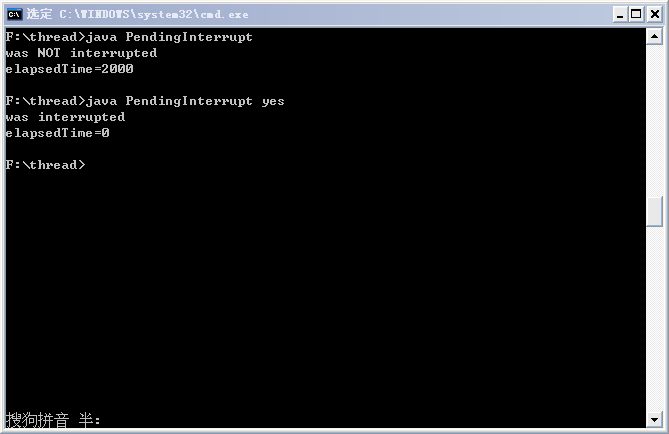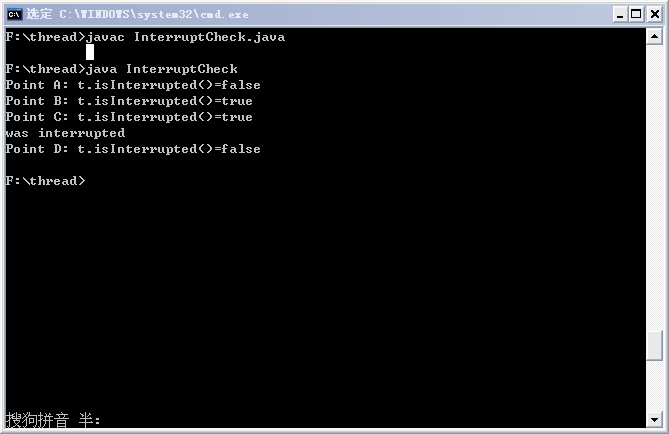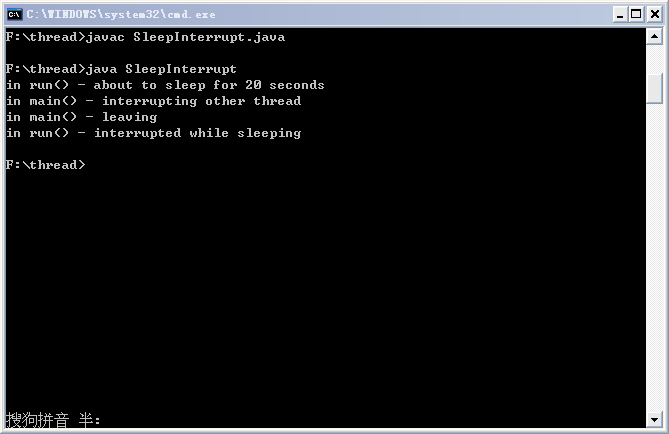转载请注明出处:http://blog.csdn.net/ns_code/article/details/17091267
使用interrupt()中断线程
当一个线程运行时,另一个线程可以调用对应的Thread对象的interrupt()方法来中断它,该方法只是在目标线程中设置一个标志,表示它已经被中断,并立即返回。这里需要注意的是,如果只是单纯的调用interrupt()方法,线程并没有实际被中断,会继续往下执行。
下面一段代码演示了休眠线程的中断:
运行结果如下:
主线程启动新线程后,自身休眠2秒钟,允许新线程获得运行时间。新线程打印信息“about to sleep for 20 seconds”后,继而休眠20秒钟,大约2秒钟后,main线程通知新线程中断,那么新线程的20秒的休眠将被打断,从而抛出InterruptException异常,执行跳转到catch块,打印出“interrupted while sleeping”信息,并立即从run()方法返回,然后消亡,而不会打印出catch块后面的“leaving normally”信息。
请注意:由于不确定的线程规划,上图运行结果的后两行可能顺序相反,这取决于主线程和新线程哪个先消亡。但前两行信息的顺序必定如上图所示。
另外,如果将catch块中的return语句注释掉,则线程在抛出异常后,会继续往下执行,而不会被中断,从而会打印出”leaving normally“信息。
待决中断
在上面的例子中,sleep()方法的实现检查到休眠线程被中断,它会相当友好地终止线程,并抛出InterruptedException异常。另外一种情况,如果线程在调用sleep()方法前被中断,那么该中断称为待决中断,它会在刚调用sleep()方法时,立即抛出InterruptedException异常。
下面的代码演示了待决中断:
如果PendingInterrupt不带任何命令行参数,那么线程不会被中断,最终输出的时间差距应该在2000附近(具体时间由系统决定,不精确),如果PendingInterrupt带有命令行参数,则调用中断当前线程的代码,但main线程仍然运行,最终输出的时间差距应该远小于2000,因为线程尚未休眠,便被中断,因此,一旦调用sleep()方法,会立即打印出catch块中的信息。执行结果如下:

这种模式下,main线程中断它自身。除了将中断标志(它是Thread的内部标志)设置为true外,没有其他任何影响。线程被中断了,但main线程仍然运行,main线程继续监视实时时钟,并进入try块,一旦调用sleep()方法,它就会注意到待决中断的存在,并抛出InterruptException。于是执行跳转到catch块,并打印出线程被中断的信息。最后,计算并打印出时间差。
使用isInterrupted()方法判断中断状态
可以在Thread对象上调用isInterrupted()方法来检查任何线程的中断状态。这里需要注意:线程一旦被中断,isInterrupted()方法便会返回true,而一旦sleep()方法抛出异常,它将清空中断标志,此时isInterrupted()方法将返回false。
下面的代码演示了isInterrupted()方法的使用:
运行结果如下:

使用Thread.interrupted()方法判断中断状态
可以使用Thread.interrupted()方法来检查当前线程的中断状态(并隐式重置为false)。又由于它是静态方法,因此不能在特定的线程上使用,而只能报告调用它的线程的中断状态,如果线程被中断,而且中断状态尚不清楚,那么,这个方法返回true。与isInterrupted()不同,它将自动重置中断状态为false,第二次调用Thread.interrupted()方法,总是返回false,除非中断了线程。
如下代码演示了Thread.interrupted()方法的使用:
运行结果如下:

补充
这里补充下yield和join方法的使用。
join方法用线程对象调用,如果在一个线程A中调用另一个线程B的join方法,线程A将会等待线程B执行完毕后再执行。
yield可以直接用Thread类调用,yield让出CPU执行权给同等级的线程,如果没有相同级别的线程在等待CPU的执行权,则该线程继续执行。






















 228
228











 被折叠的 条评论
为什么被折叠?
被折叠的 条评论
为什么被折叠?








